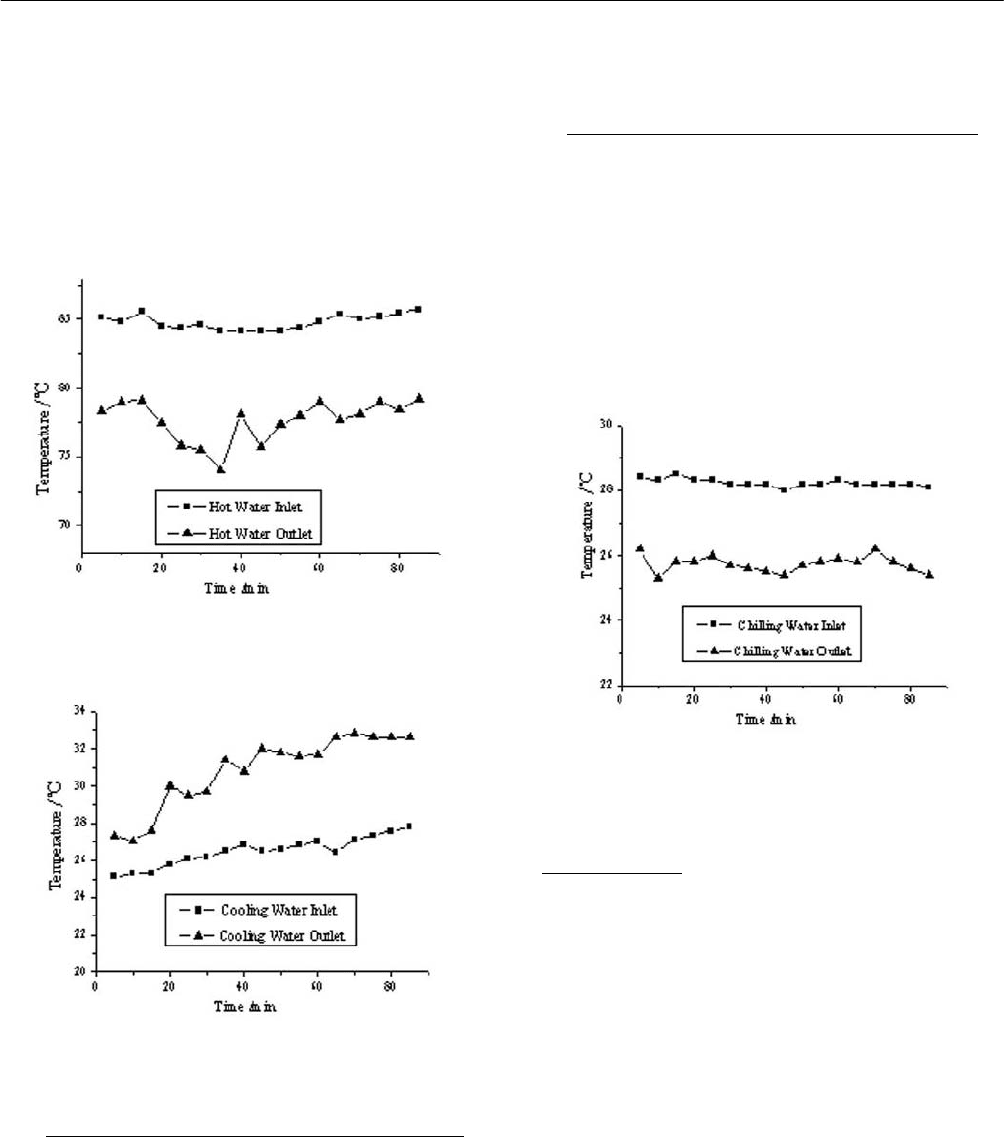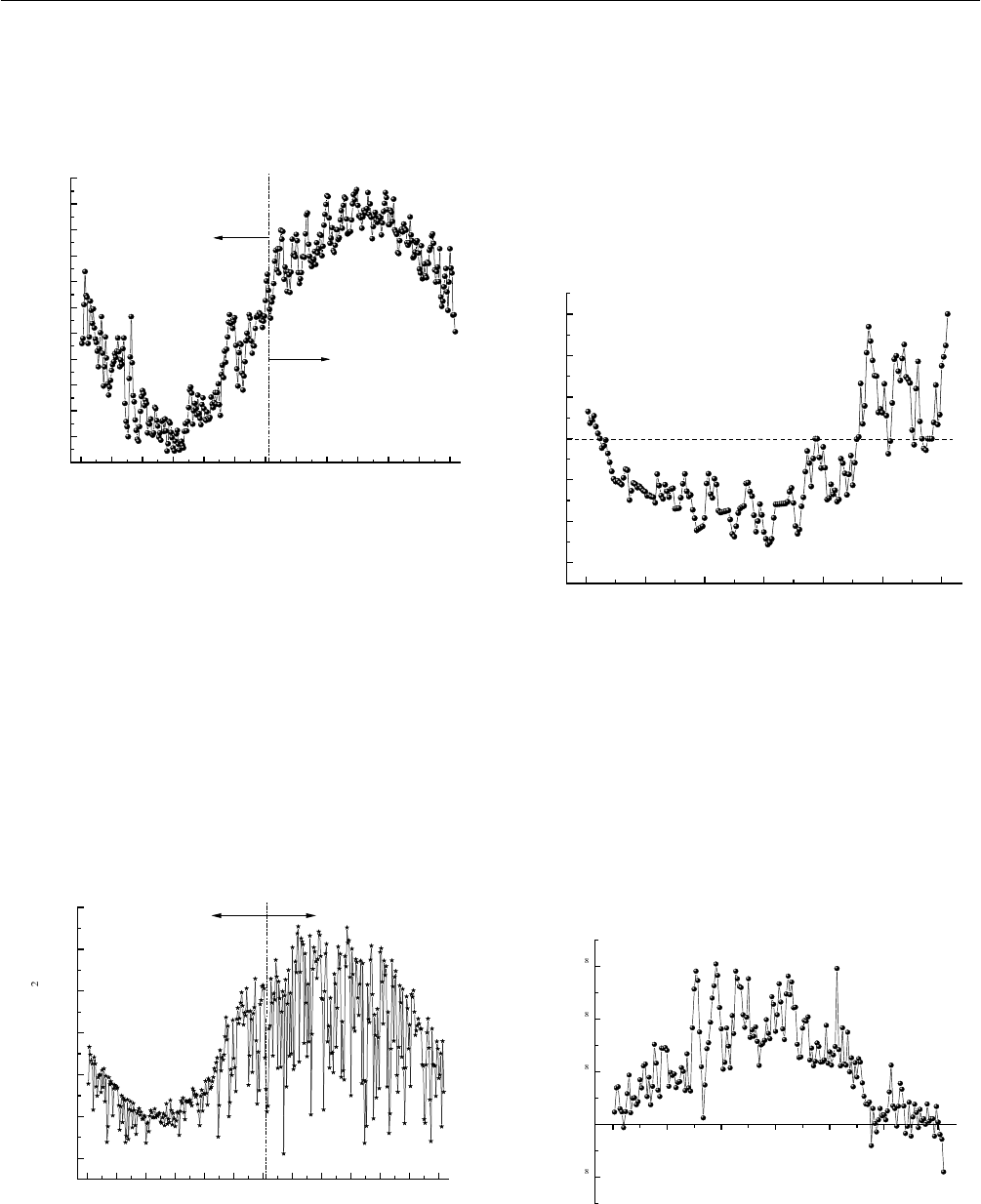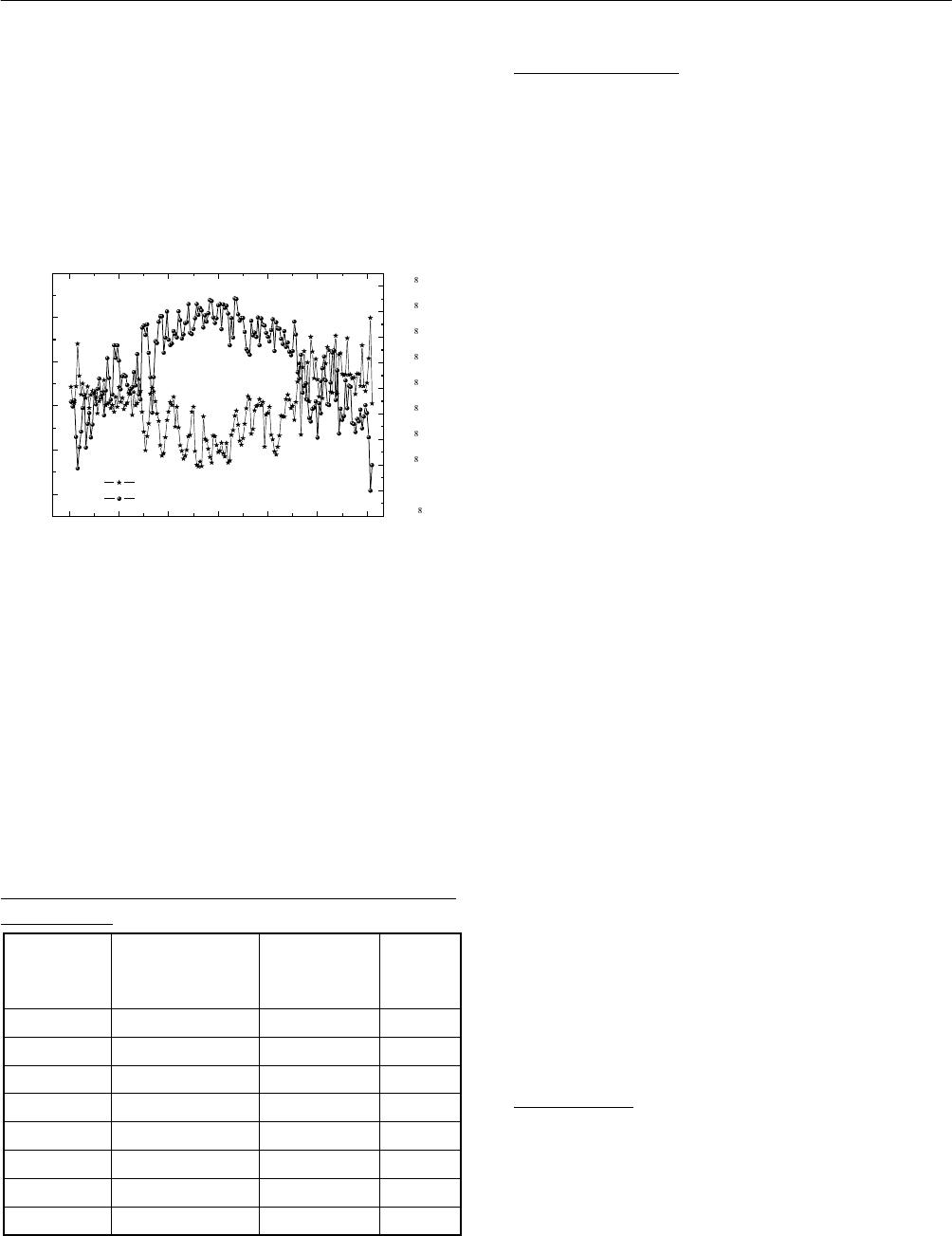Труды Всемирного конгресса Международного общества солнечной энергии - 2007. Том 2
Подождите немного. Документ загружается.


Proceedings of ISES Solar World Congress 2007: Solar Energy and Human Settlement
942
1
d
h
hdh
δ
λ
⎛⎞
=++
⎜⎟
⎝⎠
˄2˅
h = 1326.96 W/(m
2
gk)
According to (3), the heat transfer on the evaporate side is:
q
e
=hA(t
r
−t
e
) ˄3˅
q
e
= 6.704 kW
3.2 Nature Heat Tranfer
It is unavoidable that some amount of heat transfer between
the Evaporator and Absorption side in the form vapor con-
duction, convection and radiation as a result of difference
in temperature.
q = q
c
+ q
h
+ q
r
˄4˅
In which, heat-conducting amount by vapor q
c
could be
known by (2-5)˖
A
qk t
s
=Δ ˄5˅
Which is: q
c
=2.16W
and the quantity of heat convection by vapor between the
two side is found by the theory of natural convection
heat transfer in limited space as a vertical interlayer,
which is
q
h
= 4.42 W
The radiation amount q
r
is calculated by the grid scheme,
and entirely thermal resistance could be found by (6), when
q
r
is (7).
11
1
R
FF F
εε
εϕε
−−
=+ +
˄6˅
()TT
q
R
σ
−
=
˄7˅
What could be got is:
q
r
= 7.615W
So the total Nature Heat Tranfer amount is sum of the three ,
which is:
q
z
= 14.195W
3.3 Refrigerating Capacity
It can be indicated from the configuration of Evaporator-
Absorption that thermal equilibrium equation is:
q
w
= q
e
− q
z
˄8˅
where q
e
is the amount of heat transfer of falling-film
evaporation, q
n
is nature heat transfer quantity, q
w
is the
refrigerating capacity, based on previous results, which can
be calculated as follow:
q
w
=6.69 kW
The evaporated quantity of distilled water and the outlet
temperature of chilling water are computed by (9) and (10).
q
m
γ
=
˄9˅
q
tt
CG
=−
×
˄10˅
Calculating result is m
e
= 2.698 g/s and t
r2
=5.6ć,
respectively.
4. TEST DATA ANALYSIS
Some tests are taken under certain condition that how the
temperature of certain points varies along time. The data
analysis is as Fig. 3 to Fig. 5.
4.1 The Inlet And Outlet Temperature Of Hot Water
It is easy to know from Fig 3, the difference in inlet and out

3 SOLAR COLLECTOR TECHNOLOGIES AND SYSTEMS
943
let temperatures keeps at about 5ć, which meets the
theoretical value. In nearly 90 minutes, the inlet
temperature fluctuates within a narrow range, because the
hot water form outlet flows back to the hot water tank,
which makes the non-uniform temperature distribution in
the tank. The outlet temperature is affected by several
factors, such as the inlet temperature, running condition,
heat transfer inside the unit and so on.
Fig. 3: The inlet and outlet temperature of hot water curves
along time.
Fig. 4: The inlet and outlet temperature of cooling water
curves along time.
4.2 The Inlet And Outlet Temperature Of Cooling Water
The inlet and outlet temperature of cooling water becomes
higher as time goes on. The outlet cooling water flows back
to the tank, mixing with the water in it, which makes the
temperature becomes higher and distributes unevenly. At
the same, the water that has become warmer was not
replaced in time, which makes the inlet temperature of
cooling water goes higher.
4.3 The Inlet and Outlet Temperature of Chilling Water
According to Fig.5, the difference in inlet and out
let
temperatures keeps at about 3ć, which is not exactly
correspond to theoretical value. By analysis and checking
the unit, it can be explained as flows. Compared with the
original design, the inside structure is not very accurate and
the spray pipe and chilling water pipe are not fitted facing
to each other exactly. Only a part of distilled water sprays
on the chilling water pipe, which is not cooled fully.
Fig. 5: The inlet and outlet temperature of chilling water
curves along time.
5. CONCLUSIONS
In this paper, a compact absorption solar air-conditioner
system is introduced and its run mode is explained. On the
basis of theoretical arithmetic, the comprehensive heat
transfer coefficient on the Evaporator Side is calculated to
be 1326.96 W/(m
2
gk), while the distilled water absorption
ratio is 2.698g/s. The outlet temperature of chilling water is
5.6ć, and the theoretical Refrigerating Capacity is 6.69
kW, which is significant for optimal design and
improvement. By experimental study, some useful
performance curves are got. The temperature difference
between inlet and outlet chilling water is about 3 ć. Under
this operation condition, the refrigerating capacity of the
system can be got to be 2.14kW.

Proceedings of ISES Solar World Congress 2007: Solar Energy and Human Settlement
944
6. ACKNOWLEDGEMENT
This work was supported by the Natural Scientific
Foundation of China (No. 50576004) and the Basic
Research Foundation of Guangxi Province (No.0639034 ).
7. REFERENCES
(1) Conglin, “Performance Study of a Compact Solar Absorption
Air-Conditioner System”,[Master's Thesis], Beijing
Institute of Technology, 2007
(2) Hongfei Zheng, Yuyuan Wu, Hua Jiang, et al. 2003,
The study of the thermosiphon solution on elevation
tubes with lunate channel in solar absorption chiller[J],
Acta Energiae Solaris Sinica. 24(4): 466-47
1
(3) Lianying Zhang, Yuyuan Wu, Hongfei. “An experiment
investigation on performance of bubble pump with
lunate channel for absorption refrigeration system”. Int.
J. of Refrigeration, 2006, 29(5): 815-822

MODELLING AND TRANSIENT SIMULATION OF SOLAR-GROUND SOURCE
HEAT PUMP HEATING SYSTEM
Han Zongwei
School of Municipal and Environmental Engineering, Harbin
Institute of Technology, P.O. Box 235
Harbin 150090, China
taiyangshen1122@163.com
Zheng Maoyu
School of Municipal and Environmental Engineering, Harbin
Institute of Technology, P.O. Box 2644
Harbin 150090, China
zhengmaoyu@163.com
ABSTRACT
Solar - ground source heat pump (SGSHP) heating system
with phase change storage tank (PCST) is investigated. The
mathematical model of the system is developed, and the
transient numerical simulation is carried out in terms of this
model. The operation characteristic of the heating system is
analyzed during the heating period in Harbin. From the
results of the simulation, the average coefficient of
heating performance (COHP) of the heating system is
3.28 in heating period. In the initial and latter heating
period, the COHP is higher, because the system can be
operated without heat pump. During the middle heating
period the COHP and the operation stability of the system
are improved due to solar energy and soil alternately or
together as the heat source of heat pump. PCST is a very
important role in operation of the system. The system can
be operated more flexibly, effectively, and stably by the
charge and discharge heat of PCST, and the effect
becomes especially obvious in the initial and latter heating
period.
1. INTRODUCTION
Solar - ground source heat pump (SGSHP) heating system
have received much attention in recent years because of
the energy saving potential and environmental protection
when the systems are used in heating and cooling
applications [1].
There is some research on design, modeling, simulation,
experiments and optimization of the SAGSHP for heating
and cooling. From 1978−1981, some experimental and
theoretical researches on SAGSHP were performed by
Brookhaven National Laboratory (BNL, USA) [2].They
studied some coupling forms, that is, the use of the earth as
heat source/sink or storage element. Elasfouri and Hawas
developed a simplified model for simulating solar thermal
systems [3]. Krakow and Lin developed a computer model
for the simulation of multiple source heat pump
performance. The model was based on experimental
investigations of a solar-source heat pump and a
multiple-source heat pump system for cold climates [4].
Comakli et al. developed a dynamic simulation program for
a solar-assisted heat pump system with energy storage. [5].
Experimental performance study and exergoeconomic
analysis of a solar assisted ground source heat pump system
for greenhouse heating were done by Ozgener et al. [6]. All
above research provided the comprehensive foundation for
the design and application of SAGSHP heating system.
2. THE WORKING PRINCIPLE OF THE SYSTEM
2.1 The Component of the System
Fig. 1 shows that the system consists of five parts, which
are flat plate solar collector, PCST, vertical U tube soil
exchanger, heat pump unit, and fan coil.

Proceedings of ISES Solar World Congress 2007: Solar Energy and Human Settlement
946
Fig. 1: Schematic representation of the system.
2.2 The operation Mode of the System
For furthest utilizing solar energy and increasing the COP
of the system in heating period, the system should turn on
the corresponding operation mode when the outdoor
weather conditions change. The system has eight operation
modes:
Mode1. Solar energy directly heats room without heat
pump and excessive heat is stored in PCST by
exchanger.
SC ⇒ PCST ⇒ FC
Mode 2. PCST directly heats room without heat pump.
PCST ⇒ FC
Mode 3. Solar energy is used as heat source of heat
pump to heat room, simultaneously charges and
discharges for PCST.
SC ⇒ PCST ⇒ HP ⇒ FC
Mode 4. PCST is used as heat source of heat pump to
heat room.
PCST ⇒ HP ⇒ FC
Mode 5. The ground-source heat pump (GSHP) heats
room.
SHE ⇒ HP ⇒ FC
Mode 6. Solar energy and soil together are used as heat
source of heat pump to heat room.
SHE ⇒ SC ⇒ HP ⇒ FC
Mode 7. Stop heating, and the heat from solar collector
is stored in PCST.
SC ⇒ PCST
Mode 8. Stop heating, and the heat from solar collector
is stored in the soil around the soil
exchanger.
SC ⇒ SHE
3. MATHEMATICAL MODEL OF THE SYSTEM
The SGSHP heating system with PCST is a more
complicated system, which consists of several subsystems.
During development of the thermodynamic model, some
assumptions are made to simplify the numerical solution.
These assumptions can be summarized as follows:
(1) The temperature of PCST is homogeneous, and the
influences of stratification of temperature on the charge and
discharge heat process are ignored.
(2) The phase change material (PCM) is homogeneous and
isotropic, and its thermophysical properties of the PCM are
different for the solid and liquid phases but are independent
of temperature.
(3) The PCM behaves ideally, i.e. such phenomena as
property degradation and supercooling are not accounted
for.
(4) The PCM is assumed to have a definite melting point
(isothermal phase change).
(5) The vertical U tube exchanger is simplified as vertical
single tube, whose equivalent diameter is D
eq
˙ 2 DDŽ
(6) Comparing with the heat conduction in soil, the mass
transfer in earth is negligible; the heat transfer from earth to
soil exchanger is a pure heat condition process.
3.1 Solar Collector
When the collector turns on, the energy balance for the
solar collector can be expressed as:
()[()()]
u f Pf sco sci R sc sc e L sci am
QmCt t FAI Ut tτα=−= −−
(1)
When the collector turns off, the useful energy obtain by
the collector Q
u
˙0ˈthe temperature of absorber represents
the temperature of whole collector, and the energy balance
equation of solar collector is:
() ( )
scp
sc sc sc e sc L scp w
dt
GAIAUtt
d
τα
τ
=−−
(2)
3.2 Phase Change Storage Tank
The principle of the heat exchange in water tank is given by
exchanger
⎯
⎯⎯⎯⎯→
←⎯⎯⎯⎯⎯
water
⎯
⎯⎯⎯⎯→
←⎯⎯⎯⎯⎯
PCM. The
mathematical description of PCST can be written as
respectively:

3 SOLAR COLLECTOR TECHNOLOGIES AND SYSTEMS
947
Heat-transfer fluid (HTF) in exchanger
2()
f
Pf f he f w
dt
Cm rUtt
dx
π⋅=− −
(3)
Water in tank
( )() ()( )
dt
GmCttUAtUAtt
dτ
=−−Δ−−i
(4)
PCM in tank
()()
H
div gradt UA t
λ
τρ
∂
=+Δ
∂
ii
(5)
Enthalpy H includes the two parts in Eq. (6), which are
sensible and latent heat
HCdtLf=+
∫
ii (6)
3.3 The Vertical U Tube Soil Exchanger
The controllable equation of HTF in exchanger is given by
2
ff
x
x
fPf eq
tt
q
x
CD
υ
τ
ρπ
∂∂
+=
∂∂
(7)
Based on the above assumption, the controllable equation
of soil around the exchanger takes the following form
1
ss s
sPs
tt t
Cr
xxrr r
ρλλ
τ
∂∂ ∂
∂∂
⎛⎞ ⎛ ⎞
=+
⎜⎟ ⎜ ⎟
∂∂ ∂ ∂ ∂
⎝⎠ ⎝ ⎠
(8)
3.4 Heat Pump Unit and Fan Coil
To simplify the numerical solution, the characteristic of
heat pump unit are expressed by the fitted equations from
the manufacture’s catalog data, the heating capacity and
consumption of electricity are given by respectively
111hp ei ci
Qatbtc=−+ (9)
222
hp ei ci
P
at bt c=−+ (10)
To calculate heat supply of fan coil, the following
expression is found by fitting experimental date.
333fc fci i
Qatbtc=−+ (11)
3.5 The Thermodynamics Model for Heating Building
The transient heat load for building is evaluated by using
the equation
nam
Ld
nd od
tt
QQ
tt
−
=
−
(12)
The indoor temperature variation can be computed by
Eq.(13)
n
rm fc L
dt
GQQ
dτ
=−
(13)
4. NUMERICAL SIMULATION OF THE SYSTEM
The simulation process mainly includes two stages. The
stage 1 is from October 16 to April 15 (the heating period
in Harbin). The stage 2 is from April 16 to October 15. The
main simulation parameters are shown as Table 1.
TABLE 1: BASIC PARAMETERS OF SIMULATION
Simulation area: Harbin (lat.N45.75 ;long.E126.77 )
Design heat load Q
d
10kW
Outdoor design temperature t
od
-26ć
Indoor design temperature t
nd
18ć
Area of solar collector A
sc
30m
2
Water volume in tank V
w
0.45m
3
PCM type CaCl
2
•6H
2
O
PCM total volume V
pm
0.5m
3
PCM melting point T
m
29.9
PCM melting latent heat L 187.49kJ/kg
The number of soil exchanger n
she
3
The depth of soil exchanger 60m

Proceedings of ISES Solar World Congress 2007: Solar Energy and Human Settlement
948
The meteorological data of typical year in Harbin are
provided by national meteorological information centre of
China meteorological administration. Solar radiation and
outdoor temperature are shown as Fig. 2.
0 30 60 90 120 150 180 210 240 270 300 330 360
-25
-20
-15
-10
-5
0
5
10
15
20
25
30
The second stage
Temperature (ć)
Date
The first stage
Fig. 2(a): Curve of daily average outdoor temperature.
From Fig. 2 it is found distinctly that there is an
inconsistency between solar radiation and heat load of
building on time distribution, namely, solar radiation is
stronger in initial and latter heating period, but heat load
is smaller; heat load is larger in middle heating period, but
solar radiation is weaker. To ensure the effect of heating,
the design of system should be in terms of the weather
parameters in the middle heating period, which will lead
to the relative overmuch in initial and latter heating
period.
0 30 60 90 120 150 180 210 240 270 300 330 360
0
5
10
15
20
25
30
The second stage
Solar Radiation (MJ/m )
Date
The first stage
Fig. 2(b): Curve of daily solar radiation.
From Fig. 3, it is clear that the average temperature of
PCST is high than the melting temperature of PCM in the
initial and latter heating period. Solar energy is stored in
tank as sensible and latten heat. Due to the mostly heat
stored as latten heat in PCM, the temperature of tank is not
too higher, and the efficiency of solar collector and the
stored heat of tank are greatly increased. In the middle
heating period, the temperature is lower, and the
charge/discharge of the tank with only sensible heat.
0 30 60 90 120 150 180
0
10
20
30
40
50
60
Temperatureć
Date
t
m
Fig. 3: Curve of daily average temperature of the tank in
the first stage.
As shown in Fig. 4, the heat extracted is relatively smaller
in the initial and latter heating periods. Even the heat
extracted is negative at some day. In this stage the main
heat source of heating system is solar energy. With the solar
radiation gradually decreasing and the heat load increasing,
the heat extracted from soil correspondingly increases. In
middle heating period soil will be the main heat source.
0306090120150180
-1x10
0
1x10
2x10
3x10
Amount of heat (J/d)
Date
Fig. 4: Curve of daily total heat extracted from soil by
U-tube soil exchangers in the first stage.

3 SOLAR COLLECTOR TECHNOLOGIES AND SYSTEMS
949
From Fig. 5 we can see that in the initial and latter heating
period, the supplying heat is smaller, and the average
indoor temperature is relatively higher. In the middle
heating period, the supplying heat becomes large. But now
the average indoor temperature is lower, the lowest
temperature is 17.63ć, which is due to the discontinuously
controllable mode of the system and the heating deficiency
of GSHP heating system.
0 30 60 90 120 150 180
17
18
19
20
21
22
the daily average indoor temperature
the daily total supplied heat
Date
Temperature (ć)
-1x10
0
1x10
2x10
3x10
4x10
5x10
6x10
7x10
8x10
Supply heat (J)
Fig. 5: Curve of daily supplied heat and average indoor
temperature in the first stage.
In Harbin, the heating period is 183days. From the
simulation results we can know that the operation time of
this system is 3217 hours, where the heating condition is
2360 hours and the heat storage condition is 857 hours. The
total supplying heat is 94.83GJ and the total consumption
of electricity is 28.94GJ, and the average COP of the
heating system is 3.28. The characteristics of each mode are
shown as Table 2.
TABLE 2: THE OPERATION CHARACTERISTICS OF
EACH MODE
OPERATION
TIME (h)
SUPPLIED/
STORED
HEAT (GJ)
COHP
MODE 1 146 2.76 10.5
MODE 2 268 4.77 9.89
MODE 3 167 14.38 4.86
MODE 4 226 18.10 4.67
MODE 5 1017 35.52 2.51
MODE 6 486 19.29 3.00
MODE 7 692 18.82 —
MODE 8 165 15.50 —
6. NOMENCLATURES
A area (m
2
)
C
P
specific heat [J/(kg
⋅
K)]
D diameter (m)
F
R
heat removal factor
G
.
thermal capacity (J/K)
I solar radiation (W/m
2
)
L latent heat of PCM (J/kg)
P consumption of electricity (W)
Q heat power (W)
U heat-transfer coefficient [W/(m
2
⋅
K)]
f
l
liquid fraction
m mass flow rate (kg/s)
q heat exchange capacity per unit length (W/m)
t temperature (ć)
r radial axis (m)
x axial axis (m)
Greece letter
τ time (s)
λ thermal conductivity [W⁄(m
⋅
K)]
ρ Density (kg/m
3
)
υ velocity (m/s)
subscript
am ambient c condenser
d design value e evaporator
eh exchanger f
heat transfer
fluid
fc fan coil i input
L heat load n indoor
o output or outdoor p absorber
rm heating room s soil
sc solar collector t PCST
u useful w water
7. REFERENCES
(1) Kavanaugh SP, “Field test of vertical ground-coupled
heat pump in Alabama”, ASHRAE Trans, 1992,
98(2):p.607-616
(2) Metz P D, “the Use of Ground Coupled Thanks in Solar

Proceedings of ISES Solar World Congress 2007: Solar Energy and Human Settlement
950
Assisted Heat Pump System”, Transaction of ASME,
Journal of Solar Energy Engineering, 1982,
104(4):p366-372
(3) Elasfouri AS, Hawas MM, “A simplified model for
simulating solar thermal systems”, Energy Convers
Mgmt, 1987, 27:p1-10
(4) Krakow KI, Lin S, “A computer model for the
simulation of multiple source heat pump performance”,
ASHRAE Trans, 1983, 89:p590-616
(5) Comakli Ő, Kaygusuz K, Ayhan T, Arslan F,
“Experimental investigation and a dynamic simulation
of the solar-assisted energy storaged heat pump
system”, Solar Energy, 1993, 51:p147-158
(6) Ozgener O, Hepbasli A, “Exergoeconomic Analysis of a
Solar Assisted Ground-Source Heat Pump Greenhouse
Heating System”, Appl Thermal Eng, 2005,
25:p1459-1471

DISTRIBUTED AND STEADY MODELING OF THE PV EVAPORATOR
IN A PV/T SOLAR ASSISTED HEAT PUMP
Jie Ji, Hanfeng He, Wei He, Gang Pei, Keliang Liu
Dept. of Thermal Science and Energy Engineering,
Uni. of Science and Technology of China
Hefei 230026, China
Fax.86-551-3601652, Email:jijie@ustc.edu.cn
ABSTRACT
A specially designed direct-expansion evaporator (PV
evaporator), which is laminated with PV cells on the front
surface is adopted in a photovoltaic/thermal solar assisted
heat pump (PV/T SAHP) to obtain both thermal energy and
electricity from solar radiation. A distributed and steady
model is presented to describe the performance of the PV
evaporator. In the model, the influence of the pressure drop
on the refrigerant properties, such as evaporating
temperature, density, enthalpy, is taken into account. The
model is capable of predicting the spatial distribution of
pressure, temperature, vapor quality, void fraction and
enthalpy of the refrigerant. Two-dimensional distribution of
the evaporator temperature and PV efficiency are also
given by the model.
1. INTRODUCTION
Well know as a non-polluting, inexhaustible, and clean
energy source, solar energy has received considerable
attention in recent decades. The solar-assisted heat pump
technology and photovoltaic technology are two different
means of utilization of solar energy.
It is a well-known fact that the electrical efficiency of the
PV cells drops with the increase in operating temperature.
A PV/T system which adopts water or air as coolant of the
PV cells can overcome the limitation by bringing down its
operating temperature. The best design is to re-use the heat
energy removed by the coolant. Russell and Kern [1]
presented an indirect-expansion PV/T solar assisted heat
pump system which combines the above two solar
technologies into a single system in 1979. A water-type
PV/T collector was employed in the system for duel
production of electricity and thermal energy. They
investigated the system with TRANSYS for residence in
New York and Fort Worth climates. Analysis of the
technical and economic results was also discussed in their
research. Ito et al. [2] coupled the photovoltaic technology
with a direct-expansion solar assisted heat pump system. A
PV/T solar collector with refrigerant as coolant was
employed in their system to gain both thermal energy and
electricity from solar radiation. The experimental results
showed that the PV cells had weak influence on the thermal
performance. Hence their research mainly focused on the
thermal performance of the system. The results showed that
the coefficient of the performance (COP) of the heat pump
system could reach 6.0 when the temperature of the cooling
water in the condenser was maintained at 40 .ć
A specially designed tube-sheet direct-expansion
evaporator, which is laminated with PV cells on the front
surface is adopted in a photovoltaic/thermal solar assisted
heat pump (PV/T SAHP). To enlarge the contact area of the
copper coil and the absorbed panel, the copper coil is
located in the grooves which are formed by an aluminum
alloy panel and an aluminum panel as shown in Fig. 1. A
fraction of the solar energy incident upon the PV
evaporator is converted to electricity by the PV cells and
most of the rest is converted to thermal energy which is
